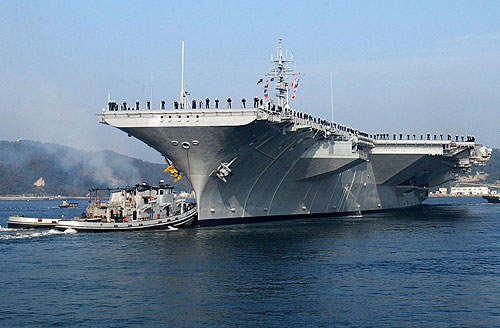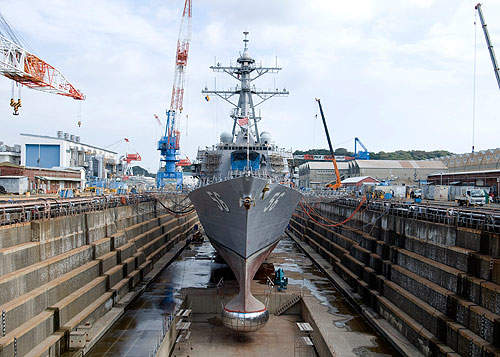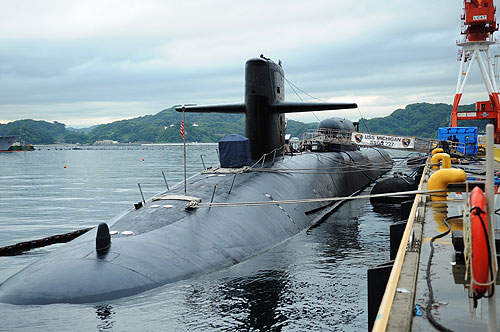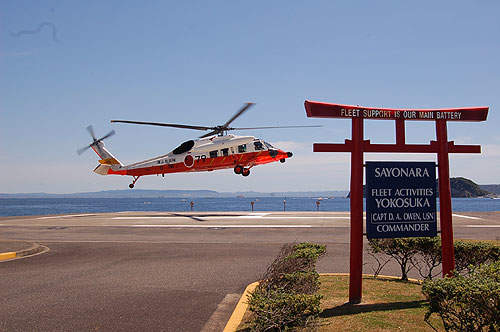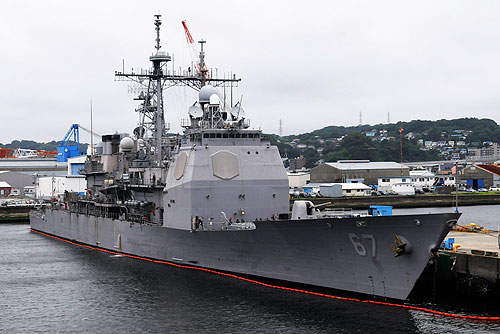Commander, Fleet Activities Yokosuka (CFAY) is a US Navy forward deployed base in Yokosuka, Japan. It is the largest overseas US Naval facility in the world and provides mission support to Seventh Fleet and Naval Forces Japan, 11 forward-deployed ships and 82 tenant commands.
CFAY is home to more than 25,000 personnel, including 9,500 US military and 2,000 US civilian employees, 8,500 family members and 5,500 contract employees. The base also has two housing detachments at Ikego, near Zushi City, and Negishi, Yokohama.
Location and layout
The base is located at the entrance of the Tokyo Bay, approximately 18 miles south of Yokohama, in the Kanto Plain region of Japan. It is situated about 30 miles south-west of the Japanese capital, Tokyo, and occupies a 568-acre site.
CFAY history
Yokosuka Naval base was built in 1860s as a 280-acre shipyard to help Japan play active role in the world trade. It was named Yokosuka Iron Works at the time, and renamed Okosuka Navy Yard in 1971. Activities at the base reached peak levels during World War II, when the yard employed more than 40,000 workers 1944.
In August 1945, the base was surrendered to the Allies and peacefully occupied by the US Marines, UK Marines and the US Naval forces. CFAY was established shortly after the occupation.
In May 1946, the marines at Yokosuka were re-designated as Marine Barracks, US Fleet Activities, Yokosuka. In April 1947, the Ship Repair Department (now US Naval Ship Repair Facility) was formed and the stores and dry docks were reactivated to handle the US Pacific Fleet.
With the outbreak of Korean War in June 1950, the base abruptly turned into a very crucial and extremely busy installation. The US Naval Hospital and the Naval Communications Facility, Yokosuka were established in 1950 and 1951 respectively.
Following the Korean and Vietnamese conflicts, the Yokosuka naval base has become the most strategic naval installation for the US in the Western Pacific.
CFAY operations
CFAY hosts 82 tenant commands, including those of the US Seventh Fleet, Commander US Naval Forces Japan, Carrier Task Force 70, Submarine Group 7, Destroyer Squadron 15, Ship Repair Facility Joint Repair Maintenance Facility, Fleet Industrial Maintenance Support Center, Naval Hospital and Afloat Training Group. These commands support operating forces through the Western Pacific, from Hawaii to the Arabian Gulf.
The primary mission of CFAY is to support the 11 high operational forward deployed warships; a command ship, an aircraft carrier, two cruisers and seven destroyers.
The base’s homeported ships are USS Blue Ridge (LCC 19), USS George Washington (CVN 73), USS Cowpens (CG 63), USS Shiloh (CG 67), USS Curtis Wilbur (DG 54), USS John S. McCain (DDG 56), USS Fitzgerald (DDG 62), USS Stethem (DDG 63), USS Lassen (DDG 82), USS McCampbell (DDG 85) and USS Mustin (DDG 89).
Garrison facilities
Yokosuka garrison facilities include six dry docks, 19 wet berths, numerous anchorages, piers and ten dedicated buildings. The base also houses the only degaussing range in the western Pacific, which is used by the US Navy and Japan Maritime Self-Defense Force.
Piedmont Pier (Berth 12) is used to berth the forward deployed aircraft carrier USS George Washington (CVN 73). Berth 12 features shore power, freeze seal air and high-pressure air systems. The base has five tugboats to assist the ship movements.
The Fleet and Industrial Supply Center at Yokosuka is the largest supply facility of the US Navy in the Western Pacific. It consists of major warehouses, cold storage facilities and fuel tanks.
Other facilities and services
The family housing towers are located in the Yokosuka, Ikego Hills and Negishi Heights areas. Bachelor housing units are provided for marines. The fleet recreation centre features shops, lounge, internet cafe, gym and a wellness centre.
Major fast-food chains such as McDonald’s, Starbucks, Sbarro, Dunkin Donuts and Baskin-Robbins have outlets at the base.


